Home (amp tone and effects placement)
Products for Controlling EQ Before Distortion
MXR - M-108 Ten Band EQ

MXR - M-108 Ten Band EQ (ext) - 10-band EQ pedal, now with bypass footswitch and Gain control. MXR108, M108.� Search Web.� Official product page.
Boss GE-7 Graphic Equalizer Pedal
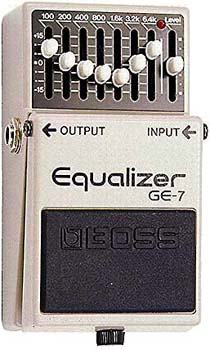
"Equalizer - The GE-7 has seven bands ranging from 100 Hz to 6.4 kHz, ideal
for guitar sounds, with boost/cut of 15dB per band. This lets you completely
control your sound and eliminate unwanted feedback, particularly when connected
after a distortion effect."
BOSS PQ3B Bass Parametric EQ Pedal
boss pq3b parametric eq pedal - listed here $89, $70
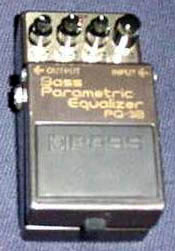
Maxon GE601 Graphic Equalizer
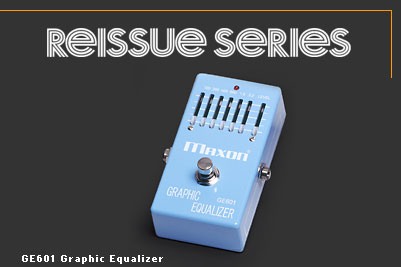
Ibanez GE-601 Graphic EQ
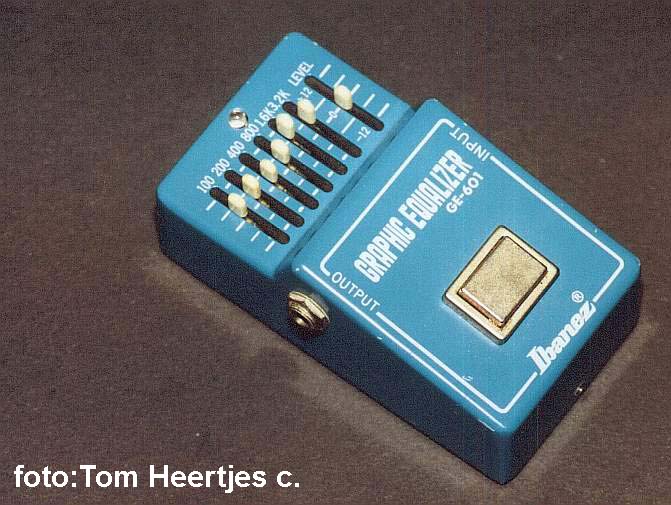
http://members.chello.nl/~t.heertjes/808/ge-601.JPG --
EH Graphic Fuzz samples at Tonefrenzy.com
Pearl
overdrive with freq and level tone controls - samples at Tonefrenzy.com
Big Jam
parametric eq pedal samples at Tonefrenzy.com
Aria parametric eq
pedal samples at Tonefrenzy.com
Ibanez PQ-401 Para EQ
Has 3 bands and a control for the mid freq.
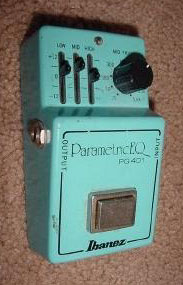
Ibanez PPE1 paraeq ped
$140
TC Electronics Dual Parametric EQ
http://www.gtrfx.com/gtrfx -- online buyers guide dedicated to guitar effects. effects previews and reviews in the FX VAULT . FX SETTINGS (http://www.rocktrax.com): how to set up your effects chain and settings for some of your favorite players.
Notch brand - The Notch paraeq - $79
Harmony Central: Effects Explained - articles on compression, EQ, parametric EQ, processing for recording
Smooth & Slim. Official product page - excerpts:
After ruminating on the thin-or-flabby dilemma for some time, he posted a couple of messages theorizing that, somewhat like Jim Marshall later implemented in his high-gain line of amps, if one were to realign selected portions of those bass frequencies before hitting the gain stages, one could get good, smooth distortion, and then the bass control could be turned up without adding flabby bottom. Gil's set out to achieve these results without the need for amplifier modifications, and eventually came up with the box that pulls off this trick, called Smooth & Slim. The distortion on the Boogie immediately became way smoother, to the point where the amp didn't sound, well, distorted. And, because I could now run up the bass without flabbiness, I recovered a good deal of the bottom end I had been losing all those years. The amp started singing with a very cool sweetness. I got really excited and spent some time comparing the tone of the amp through the Smooth & Slim and Santana's "Europa" sound off the Moonflower disk. Now, that's a great guitar tone without a doubt, but I could still hear a little raspy edge to his distortion, whereas mine had all of the good stuff, but none of that objectionable rasp. Another bonus was that I could now use my single-coil Fender Stratocaster and make it sound great as well -- Strat users are probably very familiar with the rather shrill tone that results when using these guitars in conjunction with Boogies set for overdrive. Is the Smooth & Slim for everyone? Probably not. There are lots of players who like a raw, edgy distortion, and quite a few who are perfectly happy with the clipping a stomp box delivers through a Twin. Hey, whatever's cool. On the other hand, if you're a player who likes the smooth, sweet sustain featured on Abraxas, or if you lust for a smoking Dumble Overdrive Special, to take just two examples, you owe it yourself to try out the Smooth & Slim. There are quite a few decent high gain amps out there that the average picker can latch on to for not too much green, and, with the addition of the Smooth & Slim, he/she could find him/herself in Tone Heaven quite inexpensively.
Gibson Varitone circuit
>> There is a list of varitone frequency ranges at the bottom of here. A .gif image of the ES-355/Lucille shematic with varitone is at: http://www.gibson.com/relations/schematics/diagrams/thinline.gif
> The 100k tone pots will load a normal humbucker. The series resistors (10k?) in the original circuit, but they will help to lower the Q of the notch and prevent abrupt phasing around the center point.
>>The Lucille/ES-355 is just another bright-sounding Gibson with humbuckers if you put in 500K pots instead of 100k/300K for volume/tone. For a guitar used more by Jazz players, the darker sound makes sense, and those pot values are also used on Heritage's H-555, albeit with very dark Schaller humbuckers. My schematics show a 100K resistor in series; confirmed by Don Brosnac's ref "Guitar Electronics For Musicians." He lists the Varitone pots as 500K, so it's likely that Gibson has experimented with the values over the years and reverted to the 100K/300K combo that I found in a 1990 Lucille. Brosnac's book is a terrific reference.
> Not sure if my schematic specs the value for the inductor, but that's a tough thing to find. Probably need a few Henrys (not milli or micro) to react at audio freqs.
>>Brosnac lists 1.5H, but I'm probably misrecalling the '79 Gibson schematic as 3.0H.
> Active circuits could be done easily without the inductor.
>>Yes, although most opamps have poor headroom with a 9V supply. You really want 15 Volts driving an opamp for the best sound. A single 6dB gain common emitter stage driving the Varitonesuck would help a lot, IMO. - Daniel Haney
Very-Tone Dog
Stringer Very-Tone Dog - Guitar World review excerpts:
It's a relatively low-key but extremely useful device
that makes your guitar and amp sound like a completely different animal. The
Very-Tone Dog takes its cue from the Vari-Tone circuit found on Gibson
semi-hollow guitars such as the ES-355TD and ES-345T. Using a six-position
rotary switch, the Vari-Tone is an elaborate capacitor network designed to
filter in or out certain frequencies in the guitar's pickups. With the
Very-Tone Dog, Stringer's approach was to apply the Vari-Tone concept-and
similar circuitry-within a floor pedal, allowing you to use it with any guitar
(not just an old, semi-hollow Gibson). Has a preamp that governs the effect's
overall volume and provides varying degrees of distortion when used with the
tone circuit. The preamp can function on its own by bypassing the tone
circuitry (setting the six-position rotary switch to "Bypass" permits
the pedal to be used as a booster or micro-amp). MODEL: Snarling Dog Very-Tone
Dog
LIST PRICE: $69.95
MANUFACTURER: Stringer Industries, Box 4241, Warren, NJ 07059; (908) 469-2828
DigiTech MIDI-controlled rack-mount graphic EQs ($440) - can put one of these on either side of a mic'ed, low-power tube amp. Don't touch the controls on the tube amp. Use the EQs to make the tube-amp sound programmable.
Carl Martin 3-band parametric preamp. Low-noise eq pedal. $248. (can put before distortion for voicing shaping. low-noise is important there.)
Bartolini - various onboard preamps with active EQ. Controls pre-dist EQ for
distortion voicing.
NTMB bass/mid/treb low-noise, $88.
NTMB18: 18-volt preamp. Bass, mid, treb. Switchable mid (250 hz - 1kHz). Call
for quote.
NTCT bas/mid/treb, $73.
NTCT-H high-gain bas/mid/treb, $73.
EZQ: parametric low/mid/highpass filter, $83
Mid-boost units $17.
Onboard buffer amps $38
Way Huge - Tone Leper Midboost, $175
RFX940 Solo EQ. 8-band EQ pedal, 2 level sliders, + 15 dB per band, headphone out.
TC Electronics Sustain??? Equalizer pedal
DOD FX-40B 7-band graphic EQ pedal. $120. I have this.
BOSS has a 7-band eq pedal I use. Ordinary EQ pedals really aren't quiet enough to use before distortion. Best is rackmount, MIDI-controlled (Digitech makes these; I have a contact and brochure for that).
Fishman Pro-EQ. $179. Preamp/eq. Vol, 3-band eq, brilliance sliders. For acoustic & electric guitars. Has sub-bass trim control. -- Martin / Fishman Pro-EQ. Musician's Friend price: $140. List $190. Outboard EQ. Sliders for vol, bass, mid, treb, brilliance, sub-bass trim control [pot or sw?] and phase reversal switch. Fro piezo or magnetic pickup. Belt clip. 9v batt. [sub-bass trim could help just like the Smooth and Slim, elsewhere on this page. Brick-wall the low bass out of existence, then you can turn up the bulk of the bass spectrum without farting/flabbing your distortion/saturation voicing.]
L.R. Baggs - Para Acoustic DI/EQ. [might be for piezo pickups only??] $198. Outboard preamp with 5-band parametric eq, tunable notch filter, fx loop, and gain. $198.
In 1990 Guitar Player, ad: I.S.I. Para-Q Parametric EQ, small, $60. Number is/was: 800 537 5199
Furman Sound has many eq's, but are they MIDI? For example: PQ-4 $379. 4-band parametric eq, rackmount. 20dB boost.
Way Huge Products - Tone Leper Midboost. Floor unit w/ mid-freq boost. $175.
[for pre-dist EQ]
mrhuge95 at aol.com Way Huge Products
Torres Engineering - Super Midrange for Guitars - $14. Prewired variable midrange control.
Chandler - Tone X. Active mid-boost circuit with push-pull pot, like a wah pedal at your fingertips. Fits most guitars without modification. 9volt. $80. Ad page 141 GP Oct 1992. Push-pull wah circuit that replaces the guitar's tone control and uses 9v batt. On Tin Machine's Oy Vey Baby album, Reeves Gabrels uses it for on-command singing feedback, honking resonant solo boosts, and classic british wah effects. Chandler's address in that old ad is: 370 Lang Rd, Burlingame, CA 94010. (415) 342-1490. Reeves says, "Tone X puts that elusive sweet spot at your fingertips."
Griblin Engineering - "Midrange Speaker". Pre-wired tone control. $12.95
Griblin Engineering - Custom Wiring Harness. Pre-wired strat-style harness with Rio Grande, Van Zandt, or Lindy Fralin pickups. Advanced midrange, Woman Tone, volume control with treble retention, 5-way switch, pickup covers. $239-279.
Active pickups and onboard EQ enable higher frequencies to hit the amp.
Austin - Brush the dust off your boots and get ready to plug into one awesome Overdrive pedal as the Austin Gold joins Rocktron's pedal family. A superb blend of light overdrive that enhances, without changing, the sound of your favorite amp. Unique to the Austin Gold is its "Pre-Bass" control... eliminates problems with too much "fuzzy" bass, or the opposite problem of being a weak and thin sounding overdrive. With the Pre-Bass control, many overdrive textures can be exploited. It's almost like having an entire arsenal of various overdrive pedals in one, by simply adjusting one control! With its simple control layout of "Drive", "Pre-Bass" and "Level", the Austin Gold is very simple to use. By adding a maximum of 30dB of gain, it will not overprocess, but instead will add an entirely new dimension to your amp setup! Review.
Amptone.com ultra gear-search page
Home (amp tone and effects placement)